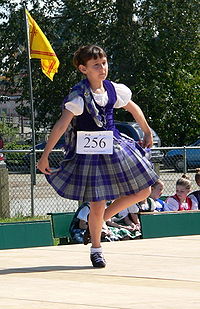
Aboyne dress
Encyclopedia

Description

Bodice
A bodice, historically, is an article of clothing for women, covering the body from the neck to the waist. In modern usage it typically refers to a specific type of upper garment common in Europe during the 16th to the 18th century, or to the upper portion of a modern dress to distinguish it from...
or elaborate waistcoat
Waistcoat
A waistcoat or vest is a sleeveless upper-body garment worn over a dress shirt and necktie and below a coat as a part of most men's formal wear, and as the third piece of the three-piece male business suit.-Characteristics and use:...
, decorative blouse
Blouse
A blouse is a loose-fitting upper garment that was formerly worn by workmen, peasants, artists, women and children. It is typically gathered at the waist so that it hangs loosely over the wearer's body. Today, the word most commonly refers to a woman's shirt but can also refer to a man's shirt if...
, full tartan skirt
Skirt
A skirt is a tube- or cone-shaped garment that hangs from the waist and covers all or part of the legs.In the western world, skirts are usually considered women's clothing. However, there are exceptions...
and some times a petticoat
Petticoat
A petticoat or underskirt is an article of clothing for women; specifically an undergarment to be worn under a skirt or a dress. The petticoat is a separate garment hanging from the waist ....
and apron
Apron
An apron is an outer protective garment that covers primarily the front of the body. It may be worn for hygienic reasons as well as in order to protect clothes from wear and tear. The apron is commonly part of the uniform of several work categories, including waitresses, nurses, and domestic...
. Some have a tartan
Tartan
Tartan is a pattern consisting of criss-crossed horizontal and vertical bands in multiple colours. Tartans originated in woven wool, but now they are made in many other materials. Tartan is particularly associated with Scotland. Scottish kilts almost always have tartan patterns...
sash (usually draped over the shoulder and coming down towards the hem of the skirt in the back) rather than an apron. While appearing to be simple and plain (and poorly-assembled), a properly-made, modern Aboyne dress might and can be quite expensive.
History
The name derives from the Aboyne Highland Gathering in ScotlandScotland
Scotland is a country that is part of the United Kingdom. Occupying the northern third of the island of Great Britain, it shares a border with England to the south and is bounded by the North Sea to the east, the Atlantic Ocean to the north and west, and the North Channel and Irish Sea to the...
where, in the 1970s
1970s
File:1970s decade montage.png|From left, clockwise: US President Richard Nixon doing the V for Victory sign after his resignation from office after the Watergate scandal in 1974; Refugees aboard a US naval boat after the Fall of Saigon, leading to the end of the Vietnam War in 1975; The 1973 oil...
the dance committee, dissatisfied with the state of affairs of female Highland dance attire, prescribed new rules governing acceptable and better-looking attire for the female dancers. The problem, as they saw it, was that many felt that the female and male dancers should not be wearing the same outfits and that a separate style for females should be developed. The men would continue to dance in kilt
Kilt
The kilt is a knee-length garment with pleats at the rear, originating in the traditional dress of men and boys in the Scottish Highlands of the 16th century. Since the 19th century it has become associated with the wider culture of Scotland in general, or with Celtic heritage even more broadly...
and jacket, wearing bonnets
Tam o'shanter (hat)
A Tam o' Shanter is a Scottish style hat originally worn by men. The hat is named after a character in a poem written by Robert Burns in 1790...
and sporran
Sporran
The Sporran is a traditional part of male Scottish Highland dress. It is a pouch that performs the same function as pockets on the pocketless Scottish kilt....
s.
The original decision of the Aboyne committee applied to both the Highland dances and the National dances. This was modified by the Scottish Official Board of Highland Dancing (SOBHD) a few years later so that the Aboyne
Aboyne
Aboyne is a village on the edge of the Highlands in Aberdeenshire, Scotland, on the River Dee, approximately west of Aberdeen. It has a rugby club, which plays on The Green and also has a swimming pool, a golf course with 18 holes, all-weather tennis courts, and a bowling green...
dress would be used by females for just the national dances with a different, kilt-based outfit (though with no bonnet or sporran for females) for the Highland dances. To this day, however, the wearing of the kilt by females is strictly forbidden at the Aboyne Gathering except for when performing two specific dances, the Pas de Basques
Pas de Basques
In Highland dance, a pas de basques is described as follows:Prepare with an extension of the working foot to second aerial position low. Spring to that side, bringing the new working foot into third or fifth position on the half point...
and the Pas de Basques and Highcuts
Pas de Basques and Highcuts
Pas de Basques and Highcuts is one of the first dances taught in Highland Dance. This dance is exactly the same as the first step of the Sword Dance, but is danced to the front, without the use of swords. It is usually taught to young dancers who are not yet prepared to learn the entire Sword...
.

